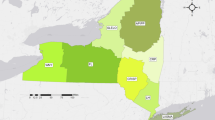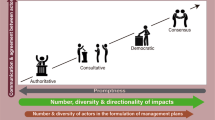Abstract
The successful management and eradication of invasive species is often constrained by insufficient or inconsistent funding. Consequently, managers are usually forced to select a subset of infested areas to manage. Further, managers may be unaware of the most effective methods for identifying priority areas and so are unable to maximize the effectiveness of their limited resources. To address these issues, we present a spatially explicit decision method that can be used to identify actions to manage invasive species while minimizing costs and the likelihood of reinvasion. We apply the method to a real-world management scenario, aimed at managing an invasive aquatic macrophyte, olive hymenachne (Hymenachne amplexicaulis), which is one of the most threatening invasives in tropical Australia, affecting water quality, freshwater biodiversity, and fisheries.


Similar content being viewed by others
Notes
A feature is any biodiversity element that is targeted in a conservation plan (e.g., a species, habitat type, or natural process). The conservation features of interest for this work are stream reaches and wetlands which coincide with the units of conservation assessment (i.e., planning units).
References
Adams VM, Pressey RL, Naidoo R (2010) Opportunity costs: who really pays for conservation? Biol Conserv 143:439–448
Armour J, Cogle L, Rasian V et al (2004) Sustaining the wet tropics: a regional plan for natural resource management. Rainforest CRC and FNQ NRM Ltd., Cairns, p 115
Ball IR, Possingham HP, Watts M (2009) Marxan and relatives: software for spatial conservation prioritisation. In: Moilanen A, Wilson KA, Possingham HP (eds) Spatial conservation prioritisation: quantitative methods and computational tools. Oxford University Press, Oxford, pp 185–195
Ban NC (2009) Minimum data requirements for designing a set of marine protected areas, using commonly available abiotic and biotic datasets. Biodivers Conserv 18:1829–1845
Beger M, Linke S, Watts M, et al (2010) Incorporating asymmetric connectivity into spatial decision making for conservation. Conserv Lett. doi:10.1111/j.1755-263X.2010.00123.x
Cade BS, Terrell JW, Schroeder RJ (1999) Estimating effects of limiting factors with regression quantiles. Ecology 80:311–323
Cantor SB, Sun CC, Tortolero-Luna G et al (1999) A comparison of C/B ratios from studies using receiver operating characteristic curve analysis. J Clin Epidemiol 52:885–892
Carwardine J, Wilson KA, Watts M, et al. (2008) Avoiding costly conservation mistakes: the importance of defining actions and costs in spatial priority setting. PLoS One 3 Article No.:e2586
DERM (2009) Queensland department of environment and resource management’s regional ecosystems. http://www.derm.qld.gov.au/wildlife-ecosystems/biodiversity/regional_ecosystems/index.php. Accessed 15 Feb 2009
Elith J, Graham CH, Anderson RP et al (2006) Novel methods improve prediction of species’ distributions from occurrence data. Ecography 29:129–151
Epanchin-Niell RS, Hastings A (2010) Controlling established invaders: integrating economics and spread dynamics to determine optimal management. Ecol Lett 13:528–541
Epanchin-Niell RS, Hufford MB, Aslan CE et al (2010) Controlling invasive species in complex social landscapes. Front Ecol Environ 8:210–216
ESRI (2006) ArcGIS 9.2. Environmental Systems Research Institute, Redlands
Fielding AH, Bell JF (1997) A review of methods for the assessment of prediction errors in conservation presence/absence models. Environ Conserv 24:38–49
Firn J, Rout T, Possingham H et al (2008) Managing beyond the invader: manipulating disturbance of natives simplifies control efforts. J Appl Ecol 45:1143–1151
Game ET, Grantham HS (2008) Marxan user manual: for Marxan version 1.8.10. University of Queensland, Australia, and Pacific Marine Analysis and Research Association, British Columbia, Canada
Gordon E, Yasmira FEO (2007) Growth dynamics of Hymenachne amplexicaulis in a herbacous wetland in Miranda State (Venezuela). Acta Botanica Venezuela 30:1–18
Gosper CR, Vivian-Smith G (2006) Selecting replacements for invasive plants to support frugivores in highly modified sites: a case study focusing on Lantana camara. Ecol Manage Restorat 7:197–203
Hermoso V, Linke S, Prenda J, et al (2010) Addressing longitudinal connectivity in the systematic conservation planning of fresh waters. Freshw Biol. doi:10.1111/j.1365-2427.2009.02390.x
Hernandez PA, Graham CH, Master LL et al (2006) The effect of sample size and species characteristics on performance of different species distribution modeling methods. Ecography 29:773–785
Houston WA, Duivenvoorden LJ (2002) Replacement of littoral native vegetation with the ponded pasture grass Hymenachne amplexicaulis: effects on plants, macroinvertebrate and fish biodiversity of backwaters in the Fitzroy River, Central Queensland, Australia. Mar Freshw Res 53:1235–1244
Huber PR, Greco SE, Thorne JH (2010) Spatial scale effects on conservation network design: trade-offs and omissions in regional versus local scale planning. Landsc Ecol 25:683–695
Januchowski SR, Pressey RL, VanDerWal J, Edwards A (2010) Characterizing errors in digital elevation models and estimating the financial costs of accuracy. J Geograph Inf Sci 24(9):1327–1347
Johnson CN, VanDerWal J (2009) Evidence that dingoes limit abundance of a mesopredator in eastern Australian forests. J Appl Ecol 46:641–646
Justus J, Sarkar S (2002) The principle of complementarity in the design of reserve networks to conserve biodiversity: a preliminary history. J Biosci 27:421–435
Kemp JE, Lovatt RJ, Bahr JC et al (2007) Pre-clearing vegetation of the coastal lowlands of the Wet Tropics Bioregion, North Queensland. Cunninghamia 10:285–329
Linke S, Norris RH, Pressey RL (2008) Irreplaceability of river networks: towards catchment-based conservation planning. J Appl Ecol 45:1486–1495
Liu CR, Berry PM, Dawson TP et al (2005) Selecting thresholds of occurrence in the prediction of species distributions. Ecography 28:385–393
Magurran A (2004) Measuring biological diversity. Blackwell, Oxford
Maidment DR (2002) Arc hydro GIS for water resources. ESRI Press, Redlands
Margules CR, Pressey RL (2000) Systematic conservation planning. Nature 405:243–253
Nicholls AO, Margules CR (1993) An upgraded reserve selection algorithm. Biol Conserv 64:165–169
Odom D, Sinden JA, Cacho O et al (2005) Economic issues in the management of plants invading natural environments: Scotch broom in Barrington Tops National Park. Biol Invasions 7:445–457
Payet K, Rouget M, Lagabrielle E et al (2010) Measuring the effectiveness of regional conservation assessments at representing biodiversity surrogates at a local scale: a case study in Reunion Island (Indian Ocean). Austral Ecol 35:121–133
Phillips SJ, Dudik M (2008) Modeling of species distributions with Maxent: new extensions and a comprehensive evaluation. Ecography 31:161–175
Phillips SJ, Anderson RP, Schapire RE (2006) Maximum entropy modeling of species geographic distributions. Ecol Model 190:231–259
Pressey RL, Tully SL (1994) The cost of ad hoc reservation—a case-study in Western New South Wales. Aust J Ecol 19:375–384
Ratcliffe N, Mitchell I, Varnham K et al (2009) How to prioritize rat management for the benefit of petrels: a case study of the UK, Channel Islands and Isle of man. IBIS 151:699–708
Rondinini C, Stuart S, Boitani L (2005) Habitat suitability models and the shortfall in conservation planning for African vertebrates. Conserv Biol 19:1488–1497
Roura-Pascual N, Krug RM, Richardson DM et al (2009a) Spatially-explicit sensitivity analysis for conservation management: exploring the influence of decisions in invasive alien plant management. Divers Distrib 16:426–438
Roura-Pascual N, Richardson DM, Krug RM et al (2009b) Ecology and management of alien plant invasions in South African fynbos: accommodating key complexities in objective decision making. Biol Conserv 142:1595–1604
Sarkar S, Pressey RL, Faith DP et al (2006) Biodiversity conservation planning tools: present status and challenges for the future. Annu Rev Environ Resour 31:123–159
Segan DB, Carwardine J, Klein C et al (2010) Can we determine conservation priorities without clear objectives? Biol Conserv 143:2–4
Simberloff D (2009) We can eliminate invasions or live with them. Successful management projects. Biol Invasions 11:149–157
Sydes T (2009) Cross regional Hymenachne management strategy. Johnstone, Tully-Murray, Lower Herbert and Black River Catchments. Far North Queensland Regional Organisation of Councils
Tracey JG (1982) The vegetation of the humid tropical region of North Queensland CSIRO, Melbourne, p 124
van Wilgen BW, Richardson DM, Le Maitre DC et al (2001) The economic consequences of alien plant invasions: examples of impacts and approaches to sustainable management in South Africa. Environ Dev Sustain 3:145–168
VanDerWal J, Shoo LP, Johnson CN et al (2009) Abundance and the environmental niche: environmental suitability estimated from niche models predicts the upper limit of local abundance. Am Nat 174:282–291
Vane-Wright R, Humphries C, Williams P (1991) What to protect-systematics and the agency of choice. Biol Conserv 55:235–254
Visconti P, Pressey RL, Segan DB et al (2010) Conservation planning with dynamic threats: the role of spatial design and priority setting for species’ persistence. Biol Conserv 143:756–767
Acknowledgments
This work was supported by the Weeds of National Significance Funding Scheme, administered by the Queensland Department of Employment, Economic Development and Innovation (2009). Support was also provided by James Cook University and the Australian Research Council Centre of Excellence for Coral Reef Studies. This work would not have been possible without the full commitment and partnership of Damon Sydes, Strategic Coordinator at Cassowary Coast Regional Council, Tully, Queensland, Australia. We also thank Travis Sydes, Lynise Wearne and Robert Cobon for their unfailing encouragement and ongoing efforts to bridge the gap between research and on-ground management actions. We would also like to thank Professor Richard Pearson and the two anonymous reviewers whose copy-editing and insightful comments helped improve the manuscript.
Author information
Authors and Affiliations
Corresponding author
Rights and permissions
About this article
Cite this article
Januchowski-Hartley, S.R., Visconti, P. & Pressey, R.L. A systematic approach for prioritizing multiple management actions for invasive species. Biol Invasions 13, 1241–1253 (2011). https://doi.org/10.1007/s10530-011-9960-7
Received:
Accepted:
Published:
Issue Date:
DOI: https://doi.org/10.1007/s10530-011-9960-7




